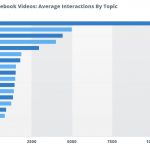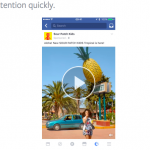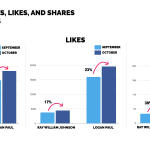How video makers are programming around Facebook’s ad breaks
Executives from Scripps Networks Interactive, Tastemade and Whistle Sports discuss how their videos accommodate Facebook’s mid-roll ads.

Videos on Facebook increasingly resemble TV-style programming — until an ad interrupts the video without a natural break in the action. But that’s beginning to change as media companies within Facebook’s video monetization program experiment with when exactly to insert an ad break in a video.
When Facebook began inserting ads in the middle of videos earlier this year, the experience was jarring. A person in a video may be speaking, then is cut off mid-sentence for a commercial. That contrasts with TV, where the programming flows from show to commercial, often with a host announcing the break or a narrative crescendoing to a climax, pausing and then cutting to black.
But, as Facebook has started to air more TV-style programming on its new Watch tab, the media companies producing those shows as well as traditional feed-based videos that are eligible to carry mid-roll ads, or “ad breaks” in Facebook’s parlance, have started to adopt TV-style strategies on how to keep viewers’ attentions through an ad break, as well as their share of the ad revenue from those mid-roll ads.
Facebook has a few requirements governing publishers’ — media companies and individual creators — use of ad breaks. Videos must be at least 90 seconds long, and an ad break cannot begin within the first 20 seconds of the video. But for the most part, publishers that are part of Facebook’s video monetization program have full control over where an ad should appear.
When uploading a video to Facebook, eligible creators can provide time codes for when they would like an ad break to be inserted, said Joe Caporoso, VP of social media at Whistle Sports, which produces sports-related videos.
Balancing content and commerce
Whistle Sports began inserting ads within its Facebook videos four or five months ago, but the company’s execs said it’s still too early for the company to have identified any hard and fast rules regarding where an ad should appear. “I’m not sure there’s a standard” dictating that an ad break should appear within the front or back half of a video, said Whistle Sports’ VP of Content J. LaLonde. “It depends on the format.”
For example, Whistle Sports produces countdown-style videos that list things like the top 25 trick shots in a given sport. In that case, the company would slot an ad after the first five entries because, by that point, it would have established a viewer’s interest in the video but not yet worn out their attention.
“The great modern challenge we have is to balance creative with commerce. We want to honor the time of the viewer while also making money off that video,” said LaLonde.
Programming around — and for — ad breaks
Digital video network Tastemade has also been trying to strike that delicate balance. Before it began inserting ads within its Facebook videos, the food- and travel-centric company’s videos on the social network often lasted around 50 seconds. But that was well short of Facebook’s 90-second requirement for a video to carry an ad. As a result Tastemade “shifted our programming strategy in a material way to have all videos early on be 90 seconds plus,” said Oren Katzeff, head of programming at Tastemade.
That strategy change was as much about ensuring Tastemade could make money from its videos as forcing its producers to develop new formats to better accommodate the longer length and corresponding ad break. In addition to adding steps to single-recipe videos, the company came up with videos demonstrating multiple ways to make a hot sauce or cook a chicken. While making those videos, Tastemade found spots within the videos that naturally catered to an ad break, such as after a dish has been placed in an oven or between recipes, and that viewers were more likely to stick around when ads were inserted at these pauses.
Beyond editing around an ad break, Tastemade has also tested how to produce videos with the ad break in mind. For its show, “Let’s Taco Bout It,” which premiered on Facebook’s Watch tab two weeks ago, Tastemade adopted the show’s late-night talk show format for its ad strategy. The show’s host, an animated taco, calls out when the show is about to cut to commercial. And for “Food to Die For,” which premiered on Watch in August and follows people who do things like dive with sharks to collect abalone, Tastemade waits until an episode’s plot builds to a climax then cuts to commercial, leaving the audience in suspense and likely to stay tuned in after the ad break. “That tends to be something that works,” said Katzeff.
When an ad should appear
“The thought process behind where an ad break goes is as important as any other consideration,” Katzeff said. “If there’s a hole in the storytelling, people can tell. If an ad is unnaturally placed, if you’re forcing it in at the 20-second mark because you want to get it in there just for the sake of monetizing, it’s not going to work.”
That being said, waiting until the end of a video to show an ad isn’t likely to work either. Not only may viewers feel like there will be less of a payoff for staying tuned in at that point, but there are typically fewer viewers as a video approaches its denouement. “When you’re trying to monetize, you want [the ad break] closer to the beginning than the end,” said Katzeff.
However, when it comes to keeping viewers through an ad break, Food Network’s and HGTV’s parent company, Scripps Networks Interactive, has seen the most success when its ad breaks appear later. “We really focus on delaying a little further out where that ad break occurs and that’s been important because we want to make sure that the audience that is there is fully committed,” said Vikki Neil, senior VP and general manager at Scripps Lifestyle Studios.
To help video makers understand when an ad break worked or did not work, Facebook provides companies in its video monetization program with analytics showing viewership retention throughout individual videos, as well as where the ad break appeared, so that companies can evaluate their videos’ watch-through rates, or the percentage of viewers that continue to watch a video after an ad break. Neil monitors the videos’ watch-through rates closely and holds weekly meetings to discuss the latest stats, though she, as well as execs from Tastemade and Whistle Sports, declined to share the figures for this article.
According to a Facebook spokesperson, as of August 2017, when Facebook has inserted a 15-second or shorter ad within videos on its social network and other publishers’ properties through its Audience Network ad network, people watch the ad to completion more than 70 percent of time.
Marketing Land – Internet Marketing News, Strategies & Tips
(33)














